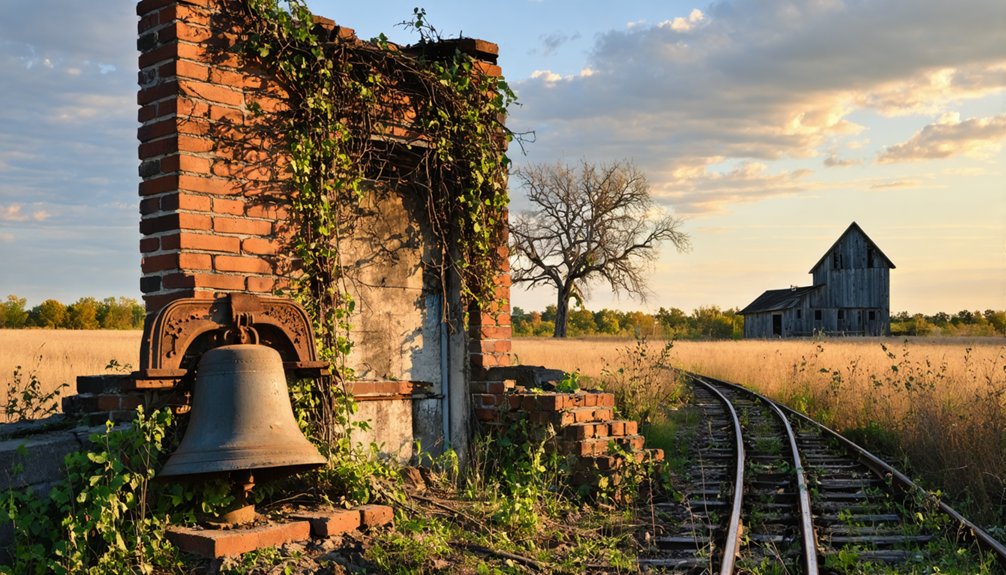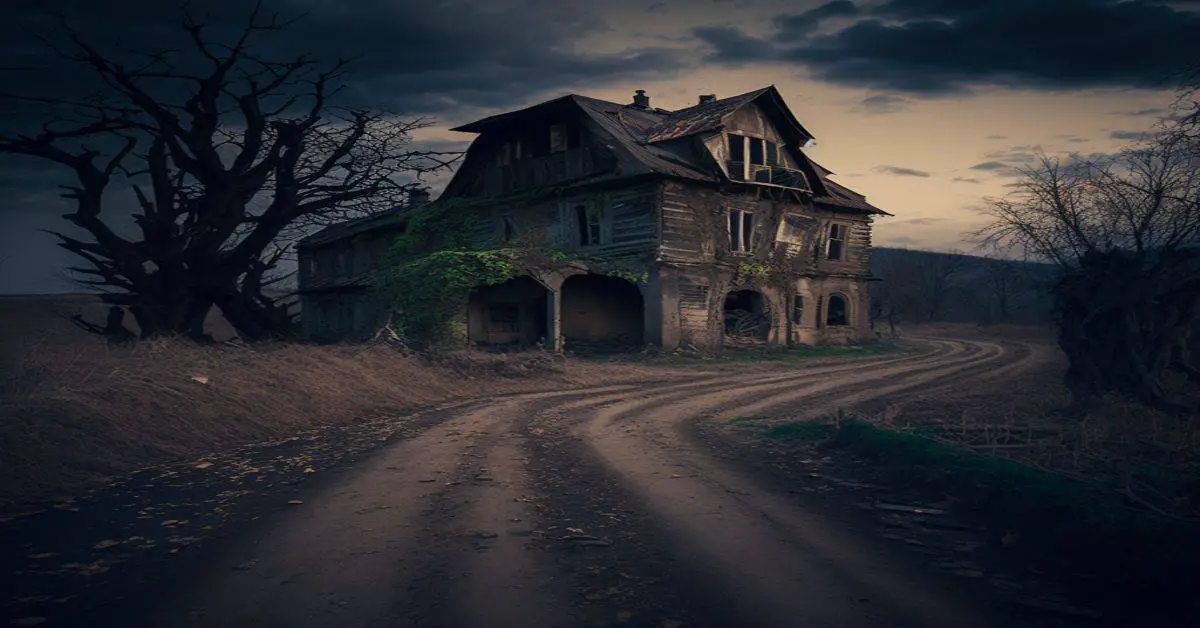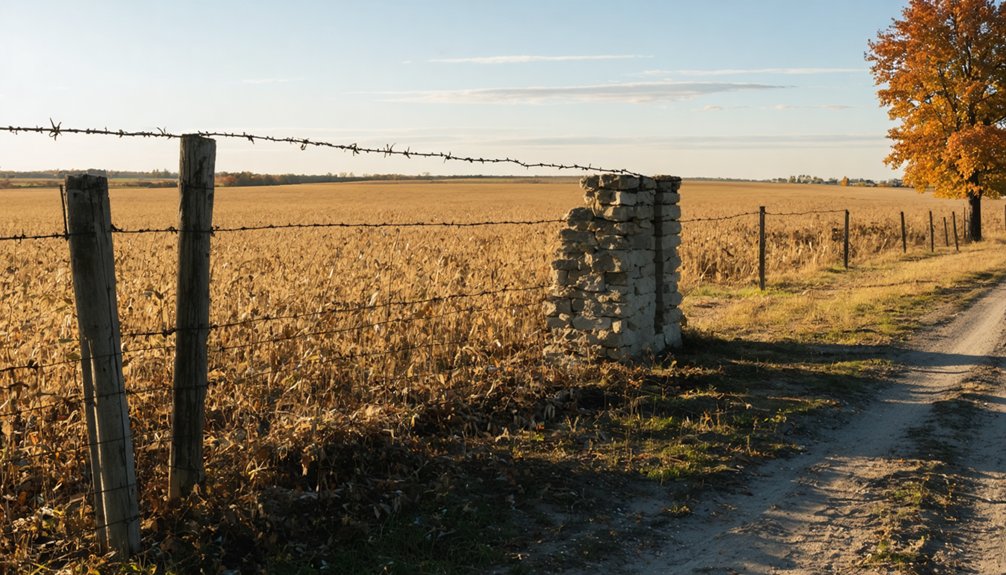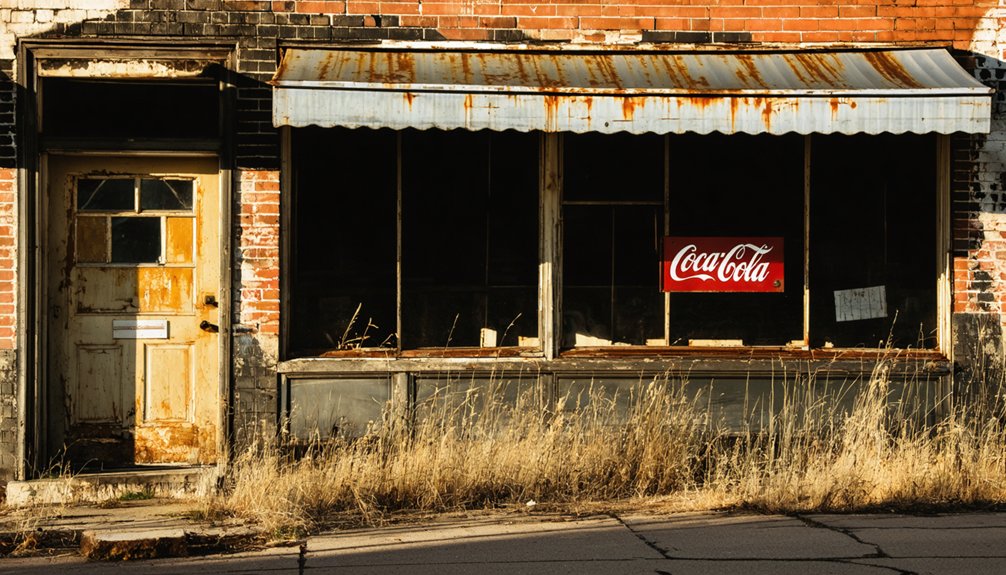You’ll find Fillmore in Douglas County’s Bourbon Township, about a mile northeast of Chesterville. Founded in 1855 and named after President Millard Fillmore, this ambitious settlement aimed to become the county seat but lost to Tuscola. The town’s isolation and lack of transportation routes hindered its growth, despite the rich prairie farmland that initially attracted settlers. While physical structures have vanished, Fillmore’s story reveals fascinating insights into Illinois’ pioneer life.
Key Takeaways
- Fillmore was established in 1855 near Chesterville in Douglas County, Illinois, but failed to secure the county seat position.
- The settlement’s isolation and lack of transportation routes significantly hindered its development and eventual sustainability.
- Located in Bourbon Township, Fillmore occupied prairie landscape at 650 feet elevation with rich soil ideal for farming.
- The town declined when rail lines bypassed it and newer roads favored neighboring communities, leading to reduced commerce.
- Today, Fillmore exists as a ghost town with few physical remains, though its agricultural heritage continues in the surrounding farmland.
Origins and Early Settlement
When Douglas County, Illinois was established in 1855, Fillmore emerged as an ambitious new settlement named after President Millard Fillmore.
You’ll find the town was officially platted on February 15th of that year, with hopes of becoming the county seat. Those dreams were quickly dashed when Tuscola claimed that honor instead.
Settler motivations centered on the area’s rich prairie grasslands, which promised excellent farming potential.
Early pioneers, mainly of German, English, and Irish descent, built simple log houses and focused on breaking the tough prairie soil for agricultural practices.
Despite the land’s fertility, Fillmore’s isolation and lack of transportation routes proved challenging.
Without access to major waterways, railroads, or established roads, the settlement struggled to attract the businesses and institutions needed for growth.
Like many lost towns of Illinois, Fillmore eventually faded into obscurity.
The settlement’s location one mile northeast of Chesterville would later prove significant in local trade patterns.
Life in Pioneer Fillmore
In pioneer Fillmore, you’d find families deeply engaged in daily farming activities, tending crops suited to the Illinois prairie while raising livestock for food and materials.
You’d witness the careful construction of homesteads using local wood and stone, with two-story homes and essential outbuildings designed to withstand harsh weather conditions. The abundant forest resources provided settlers with black walnut and oak lumber that became valuable exports for the growing community. Early settlers first utilized the region during hunting expeditions, exploring the heavily timbered wilderness.
As the community grew, you’d see farmers establishing trade networks through bartering systems, while relying on shared labor and mutual aid to manage their demanding agricultural workloads.
Daily Pioneer Activities
Life in pioneer Fillmore centered around agricultural pursuits and community cooperation. During your daily routines, you’d tend vegetable gardens, manage livestock grazing in woodlands, and process corn for hominy and bread.
Pioneer pastimes involved bartering with neighbors, helping build homes, and participating in militia drills and elections. The women would spend their days engaged in constant domestic work, ensuring their families’ basic needs were met. Similar to the Kelsey family, residents would gather for special occasions like Independence Day feasts.
You’d spend considerable time crafting essential items like soap, candles, and clothing while facing environmental challenges such as prairie fires and health risks from poor sanitation.
Churches formed the backbone of your social life, where you’d gather for worship and community events.
When tasks became overwhelming, you could count on neighboring families to lend a hand. Your survival depended on skills with basic tools like axes and plows, along with knowledge of food preservation and crop cultivation.
Homestead Building Methods
Building a homestead in pioneer Fillmore required careful planning and resourceful construction methods that evolved with the settlement’s growth. Pioneer families mastered sophisticated building techniques passed down through generations to ensure their homes would endure.
You’d start by selecting a site near water and establishing a foundation using local stone or sturdy log sills to protect against moisture and pests. Log construction dominated early building methods, with tight-fitting joints ensuring structural integrity against Illinois weather. The construction of proper fencing required approximately 10,000 fence rails for an 80-acre homestead.
- You’d use mechanical advantage and teamwork to raise heavy logs into place.
- Your walls would feature precise notching techniques like dovetail or saddle joints.
- You’d seal gaps between logs with mud or clay for insulation.
- Your windows would be small and few, with sturdy shutters for protection.
- You’d build essential fencing using split-rail methods or Osage Orange hedges to protect livestock and crops.
Farming and Trade Life
Pioneer farmers in Fillmore faced both isolation and self-reliance as they carved out homesteads across the Illinois prairie.
You’d have found yourself planting wheat and corn as primary crops, while maintaining kitchen gardens with pumpkins, melons, and potatoes. Your survival depended on crop diversification and keeping livestock – cattle, hogs, and chickens provided essential meat, milk, and trading goods.
Without established trade routes, you’d have hauled your grain to neighboring towns or bartered with traveling merchants. Your grain would’ve been weighed at the local scale house window before sale. Like the Illinois Corn Growers building’s outdoor scale in similar towns, these weighing stations were crucial for fair trade. Families often preserved their histories through social clubs and groups that shared farming knowledge and traditions.
Daily life meant working from sunrise to sunset, with your children helping in the fields while your wife tended the household garden and preserved food.
When help was needed, you’d rely on scattered neighbors for barn raisings and harvest assistance.
Geographic Location and Landscape
If you’re traveling through the Illinois prairie landscape of Douglas County, you’ll find Fillmore nestled within Bourbon Township, about a mile northeast of Chesterville.
The ghost town‘s location follows the traditional Midwest township grid system, placing it squarely within the vast agricultural expanse that characterizes this region of Illinois.
You’ll notice the surrounding terrain exhibits the classic prairie features of relatively flat topography and rich, fertile soil that once attracted early settlers to this area.
Prairie Setting Overview
Situated in Douglas County, Illinois, the ghost town of Fillmore occupies a classic Midwestern prairie landscape about a mile northeast of Chesterville in Bourbon Township.
You’ll find yourself at an elevation of 650 feet, where the rich prairie ecology once supported vast stretches of tallgrass prairie before agricultural development changed the terrain.
Settlement patterns followed the natural contours of this fertile landscape, with early residents establishing themselves near small streams and drainage ways.
- Temperate climate supports a long growing season ideal for farming
- Rolling terrain features rich, dark soil perfect for crops
- Native grasses like big bluestem and Indian grass once dominated
- Small streams and seasonal wetlands dot the agricultural mosaic
- Mixed hardwood forests survive in less-cultivated areas
Township Grid Location
The township grid location of Fillmore places the ghost town squarely within Bourbon Township‘s boundaries in Douglas County, Illinois.
You’ll find this abandoned settlement one mile northeast of Chesterville, nestled in the heart of Illinois’ prairie landscape. While specific grid coordinates aren’t documented in historical records, the town’s boundaries were once part of the broader agricultural expanse that characterizes this region of the state.
The grid layout of Fillmore reflects the typical organization of Midwestern prairie towns, though today you’ll see little evidence of the original settlement.
The surrounding terrain features the characteristic flat to gently rolling farmland of central Illinois, where the ghost town’s footprint has largely returned to agricultural use within Bourbon Township’s jurisdiction.
Native American Heritage
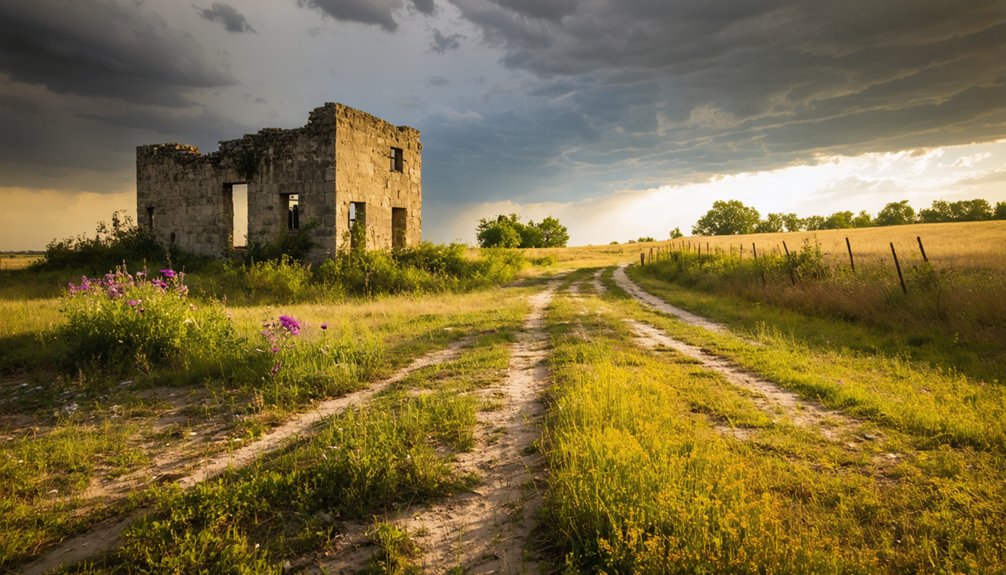
Prior to European settlement, members of the Illiniwek Confederation thrived across the Mississippi River Valley, including the area that would become Fillmore. Their cultural practices centered on seasonal migrations, following game and managing the land’s resources with deep respect for nature’s rhythms.
The Illiniwek people lived harmoniously with nature, moving with the seasons and carefully stewarding the Mississippi Valley’s abundant resources.
- Native American communities of the Illiniwek hunted, gathered, and farmed throughout the Illinois River Valley region.
- The Illiniwek’s traditional territory stretched from present-day Michigan to Arkansas.
- French explorers first encountered these tribes in 1673, leading to significant cultural changes.
- Disease and warfare decimated the local tribes following European contact.
- By 1832, treaties forced the Illiniwek to cede their ancestral lands, pushing them westward.
Today, archaeological sites throughout Illinois preserve evidence of these original inhabitants, though their direct descendants now live primarily in Oklahoma and Kansas.
The Path to Abandonment
During the late nineteenth century, Fillmore’s path toward abandonment began taking shape through a perfect storm of economic and infrastructural challenges.
You’ll find the town’s decline closely tied to transportation shifts, as rail lines bypassed the settlement and newer roads favored neighboring communities. These changes triggered devastating economic challenges, causing businesses to shutter and commerce to dwindle.
As jobs disappeared, you’d have witnessed significant population shifts, with younger residents moving to urban areas for better opportunities.
The resulting community fragmentation weakened local institutions – schools closed, social organizations disbanded, and the post office eventually shut down.
The loss of essential services created a downward spiral: fewer amenities meant fewer new residents, while aging demographics and declining birthrates further accelerated the town’s fade into abandonment.
Historical Legacy and Preservation
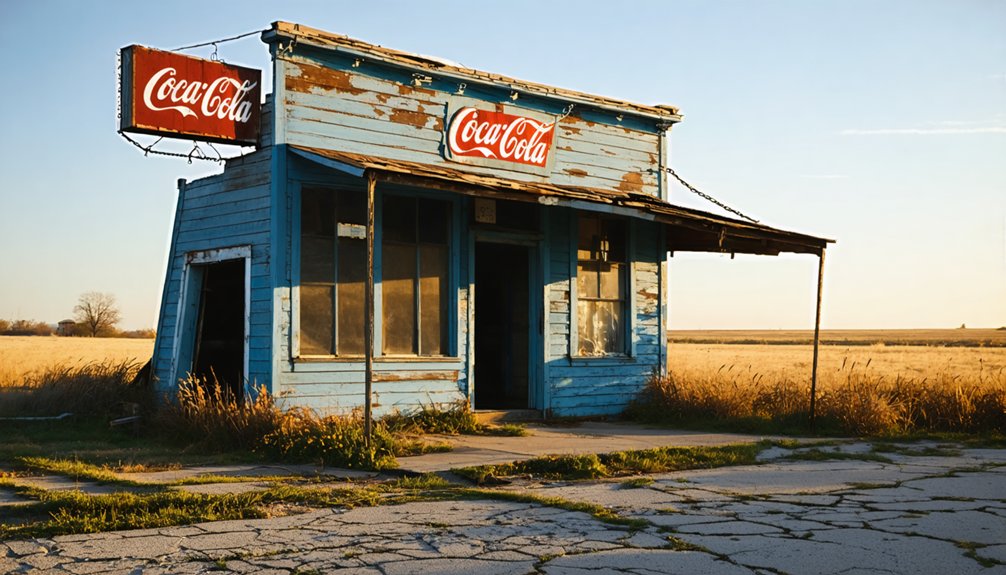
While Fillmore’s physical structures have largely vanished, you’ll find its historical legacy preserved through local archives and community memory in Douglas County, Illinois.
Though preservation challenges exist, the town’s cultural significance lives on through its connection to Bourbon Township’s agricultural heritage and rural development.
- Local historical societies maintain records of Fillmore’s past, though documentation remains limited.
- The ghost town’s location, one mile northeast of Chesterville, serves as a reminder of early settlement patterns.
- You can explore the area’s agricultural roots that once sustained this small farming community.
- State historical records acknowledge Fillmore among Illinois’ ghost towns, preserving its place in regional history.
- The town’s story intertwines with neighboring Chesterville, offering insights into rural community development.
Frequently Asked Questions
What Was the Highest Recorded Population of Fillmore During Its Existence?
You won’t find an officially recorded peak population, but based on historic growth patterns and population decline, this Douglas County settlement likely never exceeded 200 residents before becoming a ghost town.
Were There Any Notable Crimes or Scandals Associated With Fillmore?
Like searching for a needle in a haystack, you won’t find records of notable crimes or scandals in Fillmore’s history. Historical documents don’t reveal any significant criminal events or controversies.
Did Any Famous Historical Figures Ever Visit or Stay in Fillmore?
You won’t find evidence of any famous visitors or historical events involving prominent figures in this community. Historical records don’t indicate any notable personalities ever stayed or passed through here.
What Specific Businesses or Services Operated in Fillmore Before Abandonment?
You’d find a general store for groceries and dry goods, a blacksmith shop for repairs, Taylor Memorial Chapel funeral parlor, Village Hall, Mason Memorial Library, bank, and several taverns.
Are There Any Surviving Photographs or Sketches of Fillmore’s Buildings?
You won’t find publicly available photographs or sketches, as historical documentation of Fillmore’s buildings and architectural styles hasn’t been preserved in accessible archives or collections, though private collectors might hold undisclosed materials.
References
- https://drloihjournal.blogspot.com/2022/09/lost-towns-of-illinois-fillmore-illinois.html
- https://libsysdigi.library.illinois.edu/oca/Books2008-05/historicalbiogra00gresh/historicalbiogra00gresh.pdf
- http://livinghistoryofillinois.com/pdf_files/Historical and biographical record of Douglas County
- https://www.youtube.com/watch?v=gM3ZIgtFzBk
- https://drloihjournal.blogspot.com/search/label/Lost Towns of Illinois
- https://www.geotab.com/ghost-towns/
- http://genealogytrails.com/ill/douglas/bourbontwphistory.html
- https://en.wikipedia.org/wiki/Fillmore
- https://en.wikipedia.org/wiki/List_of_ghost_towns_in_Illinois
- https://www.youtube.com/watch?v=93k0qtvzkn4
